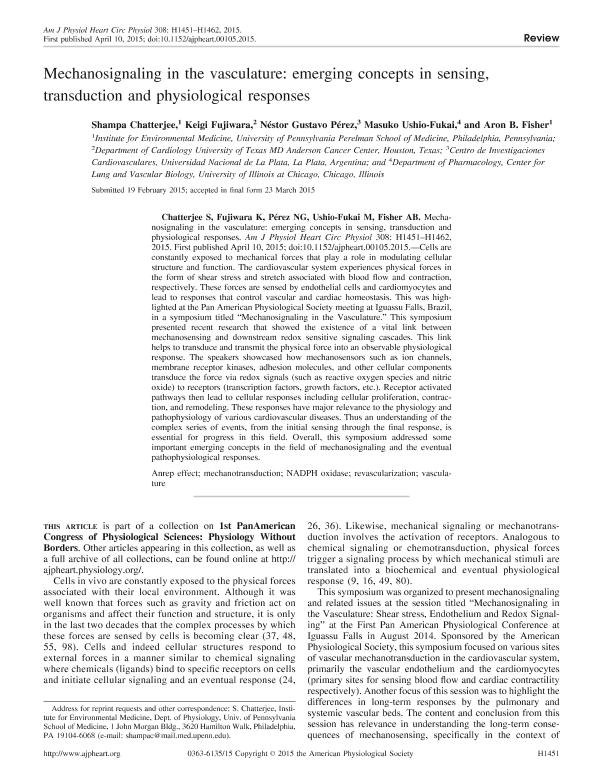Mostrar el registro sencillo del ítem
dc.contributor.author
Chatterjee, Shampa
dc.contributor.author
Fujiwara, Keigi
dc.contributor.author
Perez, Nestor Gustavo

dc.contributor.author
Ushio Fukai, Masuko
dc.contributor.author
Fisher, Aron B.
dc.date.available
2017-01-25T20:20:37Z
dc.date.issued
2015-06
dc.identifier.citation
Chatterjee, Shampa; Fujiwara, Keigi; Perez, Nestor Gustavo; Ushio Fukai, Masuko; Fisher, Aron B.; Mechanosignaling in the vasculature: emerging concepts in sensing, transduction and physiological responses; American Physiological Society; American Journal Of Physiology-heart And Circulatory Physiology; 308; 12; 6-2015; 1451-1462
dc.identifier.issn
0363-6135
dc.identifier.uri
http://hdl.handle.net/11336/11940
dc.description.abstract
Cells are constantly exposed to mechanical forces that play a role in modulating cellular structure and function. The cardiovascular system experiences physical forces in the form of shear stress and stretch associated with blood flow and contraction, respectively. These forces are sensed by endothelial cells and cardiomyocytes and lead to responses that control vascular and cardiac homeostasis. This was highlighted at the Pan American Physiological Society meeting at Iguassu Falls, Brazil, in a symposium titled “Mechanosignaling in the Vasculature.” This symposium presented recent research that showed the existence of a vital link between mechanosensing and downstream redox sensitive signaling cascades. This link helps to transduce and transmit the physical force into an observable physiological response. The speakers showcased how mechanosensors such as ion channels, membrane receptor kinases, adhesion molecules, and other cellular components transduce the force via redox signals (such as reactive oxygen species and nitric oxide) to receptors (transcription factors, growth factors, etc.). Receptor activated pathways then lead to cellular responses including cellular proliferation, contraction, and remodeling. These responses have major relevance to the physiology and pathophysiology of various cardiovascular diseases. Thus an understanding of the complex series of events, from the initial sensing through the final response, is essential for progress in this field. Overall, this symposium addressed some important emerging concepts in the field of mechanosignaling and the eventual pathophysiological responses.
dc.format
application/pdf
dc.language.iso
eng
dc.publisher
American Physiological Society

dc.rights
info:eu-repo/semantics/openAccess
dc.rights.uri
https://creativecommons.org/licenses/by-nc-sa/2.5/ar/
dc.subject
Anrep Effect
dc.subject
Mechanotransduction
dc.subject
Nadph Oxidase
dc.subject
Revascularization
dc.subject
Vasculature
dc.subject.classification
Fisiología

dc.subject.classification
Medicina Básica

dc.subject.classification
CIENCIAS MÉDICAS Y DE LA SALUD

dc.title
Mechanosignaling in the vasculature: emerging concepts in sensing, transduction and physiological responses
dc.type
info:eu-repo/semantics/article
dc.type
info:ar-repo/semantics/artículo
dc.type
info:eu-repo/semantics/publishedVersion
dc.date.updated
2017-01-25T13:57:59Z
dc.identifier.eissn
1522-1539
dc.journal.volume
308
dc.journal.number
12
dc.journal.pagination
1451-1462
dc.journal.pais
Estados Unidos

dc.description.fil
Fil: Chatterjee, Shampa. University of Pennsylvania; Estados Unidos
dc.description.fil
Fil: Fujiwara, Keigi. University Of Texas; Estados Unidos
dc.description.fil
Fil: Perez, Nestor Gustavo. Consejo Nacional de Investigaciones Cientificas y Tecnicas. Centro Cientifico Tecnológico la Plata. Centro de Investigaciones Cardiovasculares "dr. Horacio Eugenio Cingolani"; Argentina. Universidad Nacional de la Plata. Facultad de Ciencias Médicas; Argentina
dc.description.fil
Fil: Ushio Fukai, Masuko. University Of Illinois; Estados Unidos
dc.description.fil
Fil: Fisher, Aron B.. University of Pennsylvania; Estados Unidos
dc.journal.title
American Journal Of Physiology-heart And Circulatory Physiology

dc.relation.alternativeid
info:eu-repo/semantics/altIdentifier/doi/http://dx.doi.org/10.1152/ajpheart.00105.2015
dc.relation.alternativeid
info:eu-repo/semantics/altIdentifier/url/http://ajpheart.physiology.org/content/308/12/H1451
dc.relation.alternativeid
info:eu-repo/semantics/altIdentifier/url/https://www.ncbi.nlm.nih.gov/pmc/articles/PMC4469874/
Archivos asociados
